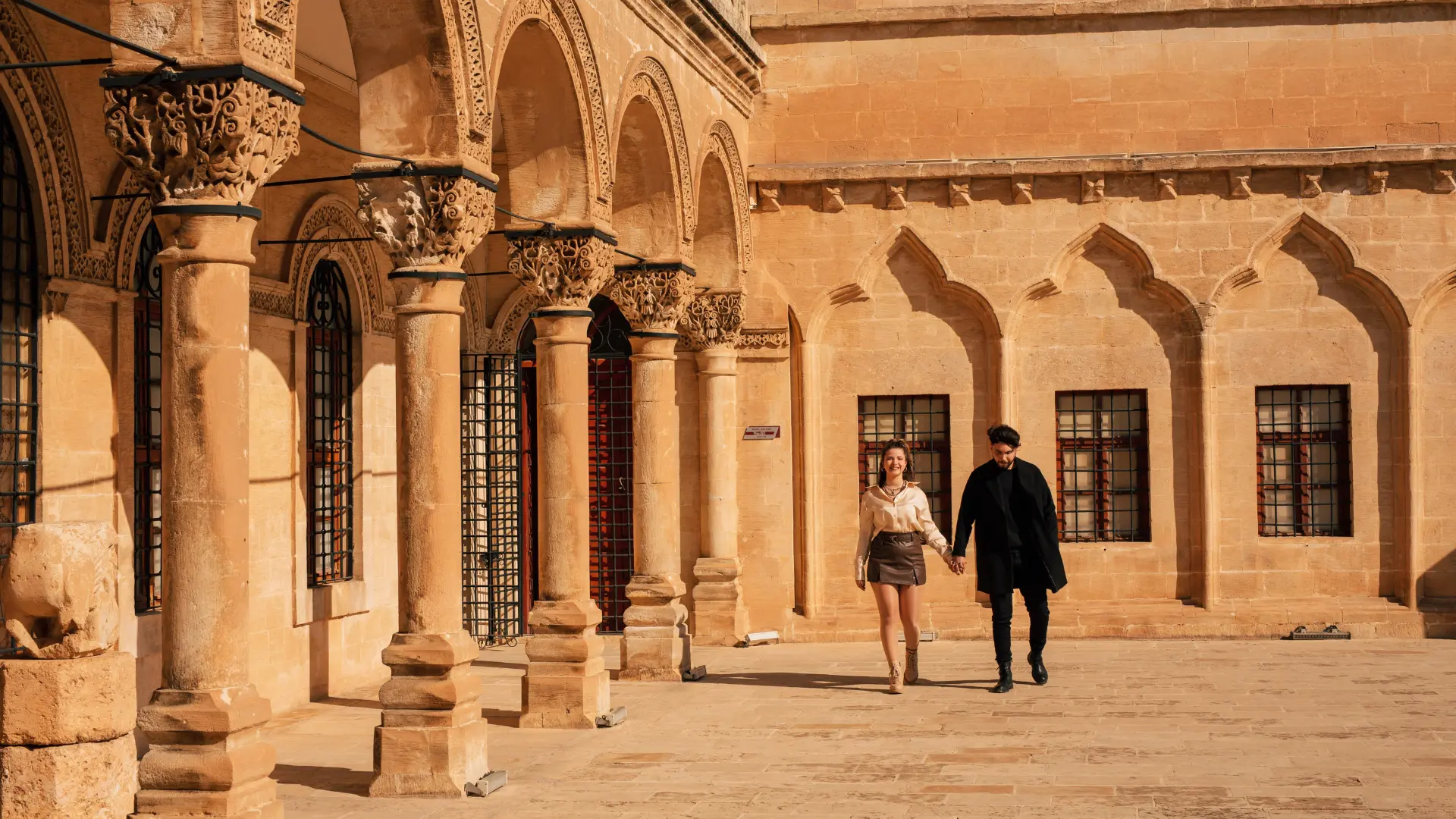Historical Walking Tours: Uncovering Turkey’s Rich Past
Your ultimate guide to the best Historical Walking Tours in Turkey.
Historical Walking Tours are the ultimate way to experience Turkey’s fascinating history. With a past that spans thousands of years, Turkey has been home to some of the world’s most influential civilizations, including the Hittites, Greeks, Romans, Byzantines, and Ottomans.
From the ancient ruins of Ephesus to the grandeur of Istanbul’s imperial mosques and palaces, historical walking tours allow travelers to immerse themselves in the country’s heritage in a way that no other mode of travel can offer.
Unlike bus tours, walking through Turkey’s historic sites provides an intimate and immersive experience, letting you explore hidden gems, admire stunning architecture up close, and enjoy the vibrant culture that fills the streets.
Whether you’re wandering through Istanbul’s Sultanahmet Square, discovering underground cities in Cappadocia, or retracing the footsteps of ancient heroes in Troy, these historical walking tours will ensure an unforgettable journey through time.
Why Choose Historical Walking Tours in Turkey?
Turkey is a living museum, rich with history, culture, and breathtaking architecture. The best way to truly appreciate its storied past is on foot, where you can immerse yourself in the atmosphere, observe intricate details, and experience daily life firsthand.
Walking allows you to take in the grandeur of Ottoman palaces, the mystique of Byzantine churches, and the remnants of ancient Roman cities at your own pace.
Unlike bus tours, historical walking tours let you engage with locals, stop for traditional food, and explore hidden alleys and markets, making the journey as enriching as the destination itself.

Benefits of Historical Walking Tours
Historical walking tours offer a unique way to experience Turkey’s rich cultural and architectural heritage. Unlike conventional tours that rush through destinations, walking allows you to slow down, immerse yourself in history, and truly connect with the places you visit. Here’s why a self-guided historical walking tour is the best way to explore Turkey:
- Flexibility – Unlike group tours, self-guided historical walking tours let you move at your own pace. You can take breaks, stop for photos, linger at sites that fascinate you, or detour to hidden gems that larger tour groups often miss.
- Authenticity – Walking through historical districts and ancient ruins allows you to experience local life firsthand. You can chat with shopkeepers in Istanbul’s Grand Bazaar, sip Turkish tea in a traditional café, or watch artisans at work in centuries-old markets.
- Deeper Understanding – By walking through historical sites, you can appreciate intricate architectural details, touch ancient stones, and stand in places where emperors, traders, and warriors once walked. This experience fosters a stronger emotional and intellectual connection to Turkey’s past.
- Sustainability – Walking is an eco-friendly way to explore, reducing your carbon footprint while enjoying the beauty of ancient cities. Unlike bus tours, walking minimizes environmental impact and allows for a more natural and mindful travel experience.
- Health Benefits – Walking is not only good for the environment but also great for your health. Exploring sites on foot keeps you active, improves circulation, and allows you to burn calories while sightseeing.
- Access to Hidden Spots – Many historical neighborhoods, ancient alleyways, and archaeological sites are only accessible on foot. Historical walking tours allow you to explore places that tour buses cannot reach, such as the narrow streets of Ephesus, the underground cities of Cappadocia, or the backstreets of Istanbul’s Old City.
- More Opportunities for Interaction – When walking, you naturally engage with locals—from street vendors selling freshly baked simit (Turkish bagels) to artisans crafting handmade carpets. This makes your journey more memorable and enriching.
- Better Photography Opportunities – Walking tours allow you to capture unique angles and details of historical landmarks. Without the rush of a tour bus schedule, you can wait for the perfect lighting to photograph Hagia Sophia, the Library of Celsus, or the fairy chimneys of Cappadocia.
With these benefits, historical walking tours provide a deeper, more rewarding, and immersive experience, making them the best way to explore Turkey’s legendary past and vibrant culture.

How to Plan a Self-Guided Historical Walking Tour in Turkey
Embarking on historical walking tours in Turkey requires some preparation to ensure an enjoyable and hassle-free experience. With its diverse landscapes, bustling cities, and ancient ruins, Turkey offers a perfect blend of history and adventure, but knowing when to visit, what to pack, and how to navigate can make a significant difference in your trip.
Best Time to Visit
Turkey’s climate varies by region, so choosing the right time for a walking tour is crucial.
- Spring (April–June) and Autumn (September–November) – These seasons offer mild temperatures, clear skies, and manageable crowds, making them the best time for historical walking tours. The blooming landscapes in spring and the golden autumn hues add to the beauty of sites like Cappadocia, Pamukkale, and Ephesus.
- Summer (July–August) – The temperatures can soar above 35°C (95°F), especially in Ephesus, Pergamon, and Cappadocia, making midday walks challenging. If traveling in summer, schedule walks for early mornings or late afternoons when the sun is less intense.
- Winter (December–February) – Istanbul and Konya can be rainy and cold, but many historical sites remain open. Cappadocia’s fairy chimneys covered in snow create a magical scene, but be prepared with warm clothing and sturdy shoes.
What to Pack for a Walking Tour
Packing the right essentials ensures comfort and enhances your experience.
- Comfortable walking shoes – Many historical sites have cobblestone streets, uneven terrain, and steep staircases, making sturdy footwear a must.
- Sun protection – A hat, sunglasses, and sunscreen are vital, especially for summer walks in open archaeological sites.
- Reusable water bottle – Staying hydrated is essential, especially in places like Ephesus and Troy, where shade is limited.
- Guidebook or offline map – While many sites have informational plaques, a guidebook or mobile app can provide deeper insights. Offline maps are useful in areas with limited connectivity.
- Camera or smartphone – Capture Turkey’s stunning historical landmarks, from the intricate tiles of Topkapi Palace to the towering columns of Ephesus.
- Modest clothing – Religious sites like mosques and Sufi lodges require modest attire. Women should carry a scarf for head covering, and both men and women should avoid shorts and sleeveless tops in religious areas.
- Portable charger – Many historical walking tours last several hours, so having a backup battery ensures you stay connected and keep your camera ready.
- Snacks and small cash – Some walking tours take you far from restaurants, so carrying light snacks is helpful. Cash is also useful for small purchases at bazaars and local cafés.
Additional Tips for Planning Your Tour
- Start early – Walking tours are best enjoyed before the midday heat and before crowds arrive at major sites.
- Plan rest stops – Turkey’s historical cities have many cozy cafés and tea houses, perfect for taking a break.
- Check entry fees and opening hours – Some archaeological sites require an entry fee and have specific visiting hours.
With proper planning, your self-guided historical walking tour in Turkey will be a memorable journey through centuries of history.
Cultural Etiquette & Safety Tips
When embarking on historical walking tours in Turkey, respecting local customs and ensuring your safety should be top priorities. Turkey is a culturally diverse country with a mix of modern and traditional values, so understanding etiquette will help you avoid unintentional disrespect and enhance your travel experience.
- Respect Religious and Historical Sites – Many of Turkey’s historical landmarks, including mosques, churches, and palaces, are still in active use. Always dress modestly when visiting religious sites; women should carry a scarf to cover their heads, and both men and women should avoid shorts or sleeveless tops inside mosques.
- Remove Your Shoes – Before entering any mosque or traditional home, you must take off your shoes as a sign of respect.
- Greet Locals Politely – Turks are generally warm and hospitable. A simple “Merhaba” (Hello) or “Teşekkür ederim” (Thank you) goes a long way in building rapport with locals.
- Avoid Climbing on Ancient Ruins – While historical walking tours often take you through archaeological sites, many ruins are fragile and protected. Climbing on ancient walls or monuments is strictly prohibited.
- Be Mindful of Photography Rules – Some sites, especially those with religious significance, do not allow flash photography. Always check posted signs before taking pictures, and ask for permission when photographing locals.
- Stay Aware of Your Belongings – Like any major tourist destination, crowded areas such as Grand Bazaar in Istanbul or Ephesus’ main entrance can attract pickpockets. Keep your bags zipped, avoid displaying valuables openly, and use cross-body bags or money belts for extra security.
- Beware of Tourist Scams – Unofficial “guides” may approach you, offering special tours or access to restricted areas. It’s best to book guides through reputable agencies or rely on self-guided historical walking tours with detailed maps and information.
By following these cultural and safety tips, you’ll not only have a more respectful and enjoyable trip but also gain a deeper appreciation for Turkey’s rich history and traditions.

Getting Around
Navigating Turkey during historical walking tours is relatively easy, thanks to well-connected public transport, pedestrian-friendly areas, and ride-sharing options. Whether you’re exploring the bustling streets of Istanbul, the ancient ruins of Ephesus, or the fairy chimneys of Cappadocia, knowing the best ways to get around can enhance your experience and help you avoid unnecessary delays or expenses.
Public Transport
- Istanbul’s tram and metro system – The city’s public transport network is efficient, affordable, and ideal for reaching historic districts like Sultanahmet, Galata, and Eminönü. The Istanbulkart (a rechargeable transit card) provides access to trams, buses, ferries, and metro lines.
- Intercity buses – For long-distance travel between cities like Istanbul, Izmir, Ankara, and Antalya, Turkey’s intercity bus system is comfortable and budget-friendly. Major companies include Kamil Koç, Pamukkale, and Metro Turizm.
- Ferries – In Istanbul, ferries offer scenic and convenient transport across the Bosphorus, connecting Europe and Asia.
Walking-Friendly Cities
- Istanbul – Sultanahmet, the Grand Bazaar, and Galata are best explored on foot due to their narrow streets and historic sites clustered together.
- Ephesus – The ancient ruins of Ephesus are a pedestrian-only site, making it ideal for a self-guided walking tour.
- Cappadocia – Towns like Göreme and Ürgüp have walking trails that connect rock-cut churches, fairy chimneys, and cave dwellings.
Taxis & Ride-Sharing
- BiTaksi app – The most reliable ride-hailing app in Turkey, helping travelers avoid overpriced taxis.
- Official yellow taxis – Always insist on using the meter to prevent overcharging.
- Private transfers – Some travelers prefer pre-booked shuttles, especially for airport transfers.
With efficient transportation options, getting around Turkey is simple and convenient, making your historical walking tours smooth and enjoyable.

Top 5 Self-Guided Historical Walking Tours in Turkey
Turkey’s historical walking tours offer an unparalleled opportunity to explore some of the world’s most important archaeological, religious, and cultural landmarks. From the grandeur of Ottoman palaces to the ruins of ancient civilizations, these self-guided walking tours allow travelers to immerse themselves in Turkey’s rich past at their own pace.
1. Byzantine & Ottoman Treasures of Istanbul (Full-Day Tour)
Istanbul, formerly Constantinople, is the epicenter of Turkey’s history, where Byzantine, Roman, and Ottoman influences converge. This walking tour explores the city’s most iconic landmarks, each representing different layers of history.
Stops & Highlights
- Hagia Sophia – Built in 537 AD, this architectural marvel transitioned from a Byzantine cathedral to an Ottoman mosque and later a museum, before being restored as a mosque in 2020. Its massive dome, mosaics, and Islamic calligraphy make it one of the world’s most awe-inspiring landmarks.
- Blue Mosque – Famous for its stunning blue İznik tiles, this 17th-century mosque is a masterpiece of Ottoman architecture, featuring six minarets and a sprawling courtyard.
- Basilica Cistern – A 6th-century underground water reservoir, supported by 336 columns, including two columns featuring Medusa heads.
- Topkapi Palace – Once the imperial residence of Ottoman sultans, this palace offers a glimpse into the luxurious lifestyle of the Ottoman Empire, featuring imperial treasures, sacred relics, and breathtaking views of the Bosphorus.
- Grand Bazaar – One of the largest and oldest covered markets in the world, dating back over 500 years. With over 4,000 shops, it’s the perfect place to buy handmade carpets, spices, ceramics, and jewelry.
2. The Ancient Wonders of Ephesus (Half-Day Tour)
Ephesus, a UNESCO World Heritage Site, is one of the best-preserved ancient cities in the world, offering a glimpse into Roman life over 2,000 years ago. Walking through Ephesus’ marble streets, travelers can admire stunning Roman architecture and engineering feats.
Stops & Highlights
- Library of Celsus – One of the most impressive ruins of the ancient world, this Roman-era library once stored 12,000 scrolls and is famous for its ornate façade and Corinthian columns.
- Great Theatre – A massive amphitheater where gladiators fought and theatrical performances were held, capable of seating 25,000 spectators.
- Temple of Artemis – Once considered one of the Seven Wonders of the Ancient World, only a few remains of this grand temple exist today.
- Terrace Houses – Lavish Roman residences featuring well-preserved mosaics, frescoes, and intricate floor patterns, showcasing the opulence of Ephesus’ elite class.
3. Cappadocia’s Rock-Cut Heritage (Full-Day Tour)
Cappadocia is one of the most unique landscapes in the world, shaped by volcanic activity and erosion. This historical walking tour offers an immersive experience in ancient cave dwellings, monasteries, and underground cities.
Stops & Highlights
- Göreme Open-Air Museum – A UNESCO-listed site, home to rock-cut churches, monasteries, and chapels dating back to the 10th and 11th centuries, with well-preserved frescoes.
- Uchisar Castle – The highest point in Cappadocia, offering panoramic views of fairy chimneys and rock formations.
- Kaymaklı Underground City – One of Cappadocia’s most intricate underground cities, used by early Christians for refuge. With tunnels, ventilation systems, and storage areas, it’s a testament to the region’s fascinating history.
- Pigeon Valley – Known for its hundreds of carved pigeon houses, once used by locals for agriculture and fertilization.
4. The Ancient Cities of Troy & Pergamon (Full-Day Tour)
This tour explores two of Turkey’s most legendary ancient cities—Troy, made famous by Homer’s Iliad, and Pergamon, a major cultural and medical center of the Hellenistic world.
Stops & Highlights
- Ruins of Troy – The legendary city of the Trojan War, where you can see ancient walls, archaeological layers, and the famous replica Trojan Horse.
- Pergamon’s Acropolis – Home to one of the steepest ancient theaters, offering breathtaking views over the Bakırçay River Valley. The site also houses the remains of the Library of Pergamon, once a rival to the Great Library of Alexandria.
- Asklepion – One of the most famous healing centers of the ancient world, where patients were treated using herbal medicine, water therapy, and dream interpretation.
5. The Silk Road & Whirling Dervishes in Konya (Half-Day Tour)
Konya, once a major stop on the Silk Road, is Turkey’s spiritual capital and home to Rumi and the Whirling Dervishes. This historical walking tour focuses on Sufi traditions, spiritual heritage, and trade history.
Stops & Highlights
- Mevlana Museum – The final resting place of Rumi, the 13th-century Sufi poet and mystic. The museum is an important pilgrimage site, displaying manuscripts, musical instruments, and Sufi artifacts.
- Alaeddin Mosque – One of the oldest surviving mosques in Turkey, built during the Seljuk Empire in the 12th century.
- Karatay Medrese – A former Islamic school known for its stunning Seljuk-era tilework and intricate geometric designs.
- Ince Minareli Medrese – A 13th-century madrasa featuring spectacular stone carvings and a museum of Seljuk artifacts.
- Traditional Dervish Performance – If visiting on a Saturday, travelers can witness a Whirling Dervish ceremony, a mesmerizing spiritual dance that symbolizes a journey toward divine love.
Final Thoughts
Historical Walking Tours offer an intimate and immersive way to explore Turkey’s rich past, bringing history to life as you stroll through ancient streets, bustling bazaars, and awe-inspiring ruins.
From the grand palaces of Ottoman sultans in Istanbul to the legendary battlefields of Troy, each step unveils the stories of empires, warriors, and visionaries who shaped civilization.
Whether you’re admiring the Byzantine splendor of Hagia Sophia, exploring the underground cities of Cappadocia, or standing where gladiators once battled in Ephesus, these tours offer a deeper, more personal connection to history.
Put on your walking shoes, embrace the journey, and uncover Turkey’s timeless heritage at your own pace!
